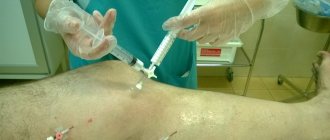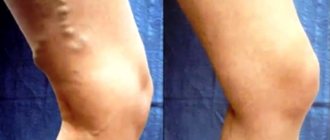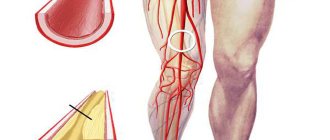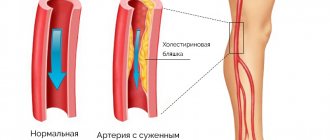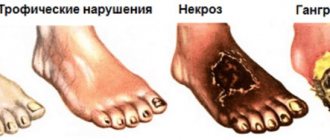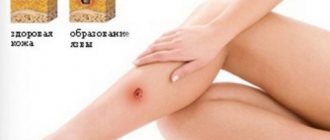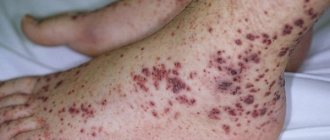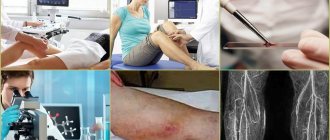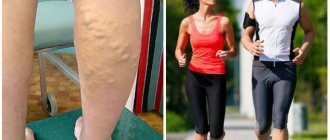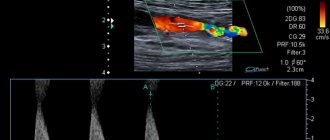Lymphovenous insufficiency is a disease caused by a malfunction of the venous and lymphatic systems. In other words, when the outflow of blood is disrupted, pressure occurs on the walls of the vein and subsequently it expands, resulting in a dysfunction of the valve apparatus responsible for normal blood circulation in the lower extremities. Due to vascular pressure, the throughput of the vein walls increases, and plasma penetrates into the surrounding tissues, causing their swelling. Insufficient blood circulation in lymphovenous insufficiency leads to overload of the lymphatic system, disruption of lymph outflow, resulting in the formation of trophic ulcers of the lower extremities.
CVI – causes of chronic venous insufficiency
CVI is a symptom complex in which there are problems with the lumen of the veins. Usually the vessels have normal lumen. If there are disturbances, the capacity of the veins is significantly reduced. Overload of the venous system leads to impaired blood return, which is manifested by the appearance of symptoms of chronic venous insufficiency.
Impaired venous blood return leads to symptoms of CVI
Is CVI dangerous? Wikipedia states that CVI actively develops and progresses in women 30-50 years old, especially those with a hereditary predisposition. Often, symptoms of CVI appear during pregnancy, when body weight increases significantly.
Among the factors leading to CVI is weak physical activity.
The appearance of CVI is provoked by:
- travel in transport without changing position;
- long static position at the workplace;
- excess weight;
- tendency to constipation;
- staying in the heat for a long time;
- straining when lifting weights.
In addition, CVI can occur with systematic exercise and taking hormonal contraceptives; CVI often occurs during pregnancy.
At-risk groups
This vascular disease is congenital due to disorders that occur during pregnancy. But often it turns out to be acquired. There are several following causes of lymphovenous insufficiency:
- The development of phlebopathy, in which there is a complex dysfunction of the veins.
- The occurrence of an injury or tumor that deforms the shape of the veins.
- Development of phlebothrombosis or varicose veins.
- The appearance of excess weight, loading the limbs.
- Excessive physical activity.
- The appearance of constipation and the effect of hormonal contraception.
- The appearance of age-related changes.
First of all, as a rule, those people who lead a sedentary lifestyle suffer. Prolonged stay in an upright position, sitting or standing, without physical activity of the legs, significantly inhibits the outflow of lymph and blood circulation.
CVI - symptoms
CVI may not manifest itself for a long time, but the symptoms that appear significantly affect the patient’s quality of life. The first symptoms are a feeling of heaviness in the legs, very often swelling of the legs and feet appears. Next comes bursting pain. The calf muscles may cramp at night, and the patient experiences a feeling of heat in the lower extremities.
Advanced forms of venous insufficiency - trophic eczema and ulcers
Spider veins and veins begin to appear through the skin, which with varicose veins become noticeable in the form of plexuses, similar to a bunch of grapes. The skin becomes drier and becomes covered with brown “islands” that grow as the disease progresses. Eventually, a trophic ulcer forms in their center.
Mechanism of disease development
Normal venous circulation is carried out in the direction from various parts of the body, including the lower extremities, to the heart. Cardiac output creates pressure, due to which blood flows through the vessels to the periphery. Under the influence of negative pressure that occurs when the heart muscle relaxes, blood flows back. There are additional mechanisms that help blood rise:
- the work of the valves of the veins prevents the blood from flowing back (regurgitation);
- vascular tone;
- muscle contraction creates pressure and promotes upward movement of blood.
Venous insufficiency of the lower extremities is formed as a result of certain processes occurring mainly in the vascular wall:
- stretching of the wall at the location of the valves leads to their loose closure;
- stagnant blood puts even more pressure on the vessel and stretches its walls, as a result it becomes deformed;
- decreased muscle tone aggravates blood regurgitation and changes in the structure of the venous wall;
- due to stagnation of blood, high pressure is created inside the blood vessel;
- the venous walls protrude, become damaged, their permeability increases, blood flows out, causing staining of the tissues surrounding the vessel.
As a result, the blood supply to the part of the body in the affected area is disrupted, cellular metabolic products accumulate, an inflammatory process occurs, an insufficient amount of oxygen enters the tissues, blood viscosity increases, and blood clots form.
CVI - stages of chronic venous insufficiency
The disease has several stages:
- first the venous wall changes;
- valves stop functioning;
- perverted blood flow occurs, leading to venous hypertension;
- varicose veins appear;
- skin pigmentation changes;
- Varicose eczema may appear;
- at this stage, thrombosis often develops, affecting the deep veins;
- complications include thrombophlebitis, pulmonary embolism.
The walls of the veins become more permeable, lymph enters the blood, trophism is disrupted and inflammation occurs (10-15% of cases). The last stage of CVI is a venous trophic ulcer (4% of cases)
Treatment
Treatment of venous insufficiency requires identifying the specific cause of the disease. It makes no sense to use only symptomatic drugs. They can only give a temporary effect.
For acute venous insufficiency of the legs, treatment is carried out in 2 stages:
- As first aid, apply a cold compress and change it every 2-3 minutes by dipping the cloth in a container of ice. These actions are repeated for about an hour.
- To subsequently relieve inflammation, it is recommended to use ointment preparations with anticoagulant components.
For chronic venous insufficiency of the extremities, it is recommended to wear compression garments and take a course of medications. If the symptoms are caused by heart failure, medications are used that increase myocardial contractility (cardiac glycosides) and remove excess fluid (diuretics). At the same time, means are needed to restore energy balance.
Management of pregnant women (as some people call a management plan in the Western style) provides for preventive measures in the form of compression stockings in the first trimester and special tights with thick pads in the lower abdomen - from the second trimester.
With increased intracranial pressure, Eufillin and diuretics have a good effect. If the cause is a tumor process, specific treatment is prescribed (chemotherapy, radiation exposure). A consultation with a neurosurgeon determines the possibility of tumor removal.
In preparing hazelnut infusion, the bark, fruits and leaves are equally important.
The following are prescribed as drug therapy:
- venotonics - Diosmin, Detralex, Phlebodia, Vasoket;
- angioprotectors - Troxevasin, Rutoside, Aescusan drops, Venoruton;
- for topical use, heparin ointment, Lyoton gel, Troxevasin, Hepatrombin are recommended;
- disaggregants that prevent the formation of blood clots - Aspirin, Dipidamol, Pentoxifylline.
For sleep disturbances, herbal sedatives are prescribed. Mental changes require consultation with a psychiatrist and combination therapy.
Great importance is attached to the elimination of risk factors. Some patients are recommended to change jobs, avoid strenuous sports, control weight, and engage in vigorous physical activity alternating with rest.
It is impossible to cope with venous insufficiency using folk remedies alone. But it is not forbidden to add herbal decoctions from the advice of healers to the main treatment:
- It is better to purchase horse chestnut extract at a pharmacy, since it is inconvenient to prepare it yourself;
- alcohol tincture of Kalanchoe is used for lotions and compresses in the treatment of trophic ulcers;
- Preparations from Sophora japonica have an anti-inflammatory, venotonic and healing effect.
All methods of therapy must be discussed with the attending physician. This is especially true for the treatment of children and pregnant women. You should not take risks and try untested products on yourself and cause harm.
CVI - Diagnostics
Typically, patients turn to a phlebologist when obvious signs of CVI are visible to the naked eye, and the diagnosis is easy to make. Specialized clinics use ultrasound methods to diagnose CVI:
- the condition of blood vessels is studied;
- assesses how blood flows through them;
- Disturbances in the functioning of venous valves are considered.
Ultrasound scanning gives a complete picture of the causes of CVI
With an ultrasound examination, the doctor receives a three-dimensional image of the vessel, reliable information about its functioning, and can make an objective diagnosis.
Main pathological changes
It is known that the venous vessels of most of the body are constantly working against the force of gravity. They push blood upward when a person is in an upright position. For this, the vein walls have sufficient muscle tone and elasticity.
Great importance is attached to the valve apparatus, thanks to which the blood mass is kept from returning to the lower sections.
Local changes in the venous vessels most often occur in the legs. Due to loss of tone and sagging valves, the liquid and thick parts of the blood overflow. The portion of the reverse flow allowed by the valves is called the amount of reflux and determines the degree of venous dysfunction.
Venous stagnation is always accompanied by two types of reactions:
- an increase in pressure inside the vessel, squeezing out the liquid part of the blood into adjacent tissues with the formation of edema;
- hypoxia of surrounding organs and tissues due to the cessation of the normal transfer of oxygen-rich arterial blood to the venous part of the capillary leg.
Latest information: Treatment of jointsWhy do you bandage your legs with an elastic bandage before surgery?
Prolonged stagnation causes diapedesis (leakage) of red blood cells through the vein wall. Minor hemorrhages form along the vessel. In the brain they cause soft spots and stroke.
Normally, the pressure in the arteries is higher, so the blood passes into the cells, and from them into the venules
In a chronic course, fibrosis or sclerosis of the vascular wall is involved in the pathological process, along with the replacement of cells with non-functioning scar elements. This is how atrophy of the skin area occurs, the organ from which blood with processed biological substances and carbon dioxide must flow out in a timely manner.
General changes occur in heart failure. Impaired blood circulation can lead to acute venous insufficiency with the development of weakness of the right chambers of the heart. In this case, the suction function, which is characteristic of the right atrium, is lost.
The loss of the liquid part of the blood and a decrease in the speed of blood flow contribute to the gluing of platelets with the formation of microaggregations, and then blood clots. The transition threatens thrombosis and thrombophlebitis of the veins, rupture of emboli and circulation in the general bloodstream.
One of the components of venous paresis is the transfer of the liquid part of the blood into the lymphatic system. The branches of the lymphatic vessels complement the venous ones and collect waste from cell activity from the interstitial spaces. For some time, they “save” and maintain the lost functionality of the veins.
Venous insufficiency of large trunks of the vena cava leads to fibrosis and atrophy of organs with loss of their functions.
CVI – complications of chronic venous insufficiency
Many patients have a common belief that CVI is not too dangerous, that it is just cosmetic. In fact, disturbances in the venous blood flow of the legs provoke the formation of blood clots. Therefore, CVI has two main complications: thrombosis and thrombophlebitis. In the first disease, the deep veins suffer:
- the affected area acquires a bluish tint,
- tissues swell
- movements are accompanied by pain.
With thrombophlebitis, blood clots form in the superficial veins. Wherein
- the skin turns red;
- Painful lumps form under the skin
- When walking, the patient experiences sharp pain in the legs.
A detached blood clot can clog a large vessel and cause death. Acute manifestations of these diseases are treated only in a surgical hospital. You can see the danger of CVI - photos, the results are on websites on the Internet.
What complications may arise?
Untimely or poor-quality treatment of venous insufficiency can lead to the development of the following complications:
- Deep vein thrombosis, which is accompanied by the formation of thrombotic masses that can completely block the lumen of the vessel.
- Thrombophlebitis, in which the inflammatory process affects the walls of blood vessels. This complication is often concomitant with thrombosis.
- Disturbances in the normal functioning of the lymphatic system. In this case, swelling bothers the patient regularly and no longer goes away on its own. This is due to a disruption in the flow of lymph in the area of the affected leg.
The danger lies in the fact that even a minor injury can lead to the development of heavy bleeding. In this case, it is recommended to bandage the affected limb as soon as possible with a tourniquet slightly above the site of injury and take the patient to the hospital. The development of bleeding from the affected, dilated vein can pose a threat to the patient’s life, so in this case you should not hesitate in any case.
CVI. How to treat the disease with creams?
Treatment with all kinds of ointments is very common at the household level. Many patients stop treatment at this point. Most ointments only temporarily relieve swelling and pain. CVI – how to treat it? This question is asked by all patients. Such popular remedies as heparin ointment, venoruton, venitan, hepatrombin cope well with the external manifestations of CVI at an early stage, but cannot eliminate its cause. For effective treatment that will give long-term results, a visit to a phlebologist or vascular surgeon is mandatory.
Stages and forms of pathology
The symptoms of the disease are not the same at different stages of its development.
- Initial stage. There are no external or painful sensations. Diagnosis is almost impossible.
- First stage. After a long walk, swelling appears. Conservative treatment can completely relieve the patient of the disease.
- Second stage. Swelling increases and becomes more difficult to get rid of. Possible pain, cramps, heaviness in the limbs.
- Third stage. At this stage, a complete cure is impossible. Previously manifested symptoms are actively progressing. Impairs leg functions. Joint deformation starts, arthrosis and arthritis appear. Treatment is practically ineffective.
CVI - how to cure without consequences?
This can be done even in difficult cases; treatment of CVI in Moscow can be carried out at a high level. True, then surgery will be needed to restore blood flow in the veins. But in the early stages, conservative treatment of CVI without surgery is sufficient. In particular, elastic compression is used. For this purpose, special medical knitwear is used in the form of stockings, golf, tights (conservative treatment).
When treating CVI, it is very important not to waste time using various ointments that give a local and short-term effect, but to seek help from a qualified specialist.
During pregnancy
Pregnant women often experience a chronic form of lymphovenous insufficiency (a photo of the manifestation of the disease is presented above). The phenomena that accompany this pathology are gestosis along with fetal hypoxia, labor disturbances and bleeding during childbirth. Against the background of a chronic form of lymphovenous insufficiency of the extremities, pregnant women may experience complications in the form of thrombophlebitis and venous thromboembolism.
There is also a risk of death. As a rule, with this pathology, pregnant women complain of the presence of pain and excessive fatigue. There are also complaints of heaviness in the limbs, night cramps and increased swelling. During pregnancy, the process of treating pathology falls, as a rule, on the shoulders of a gynecologist. The basis of treatment is:
- Conducting compression therapy.
- Use of medications.
- Use of local topical forms.
The greatest danger of the disease is the occurrence of trophic ulcers, in ordinary situations requiring mandatory surgical intervention. Conservative therapy can help improve blood supply to tissues and avoid surgery. Pregnant women who are at risk need to take care of the health of their limbs in advance. The goal of treatment and prevention is regression and stabilization of negative changes.
CVI - treatment at home
Don't be afraid if you are diagnosed with CVI. Treatment with folk remedies will alleviate the situation. For example, venotonic drugs will help. They strengthen the walls of blood vessels, stimulate microcirculation, and quickly relieve the feeling of tired legs and swelling. Patients are also treated with blood thinning medications.
Do you need to relieve the pain of CVI? Treatment with traditional methods:
- Apple vinegar. Twice a day for 30 minutes. Apply gauze soaked in vinegar to your feet for 30 minutes. Keep your legs higher. Reviews about the product are contradictory, but the majority note a positive, weak effect.
- Bell pepper. Dilute a teaspoon of pepper powder in a glass of hot water and drink three times a day. The product stops leg pain and improves blood flow. But CVI does not go away that easily, treatment, the results are still not the same as when treated by a professional phlebologist.
Some folk methods
Therapy with folk remedies can serve as an excellent addition to the main treatment of insufficiency of the venous-lymphatic system, but it should not come to the fore, replacing medications and compression garments.
The following recipes are quite popular in everyday life:
- A mixture of honey and garlic. All you need is liquid honey and regular garlic, both in the amount of 300 grams. The garlic is grated and mixed with honey, after which the finished mixture is placed in a container and infused in the refrigerator for a week. The product is used one tablespoon before meals for two months.
- Diuretic tea. Made from rose hips and currant leaves. The components are mixed and poured with boiling water, like regular tea. This remedy helps remove fluid from the body, including stagnant blood and lymph. Take half an hour before meals.
- Compresses with the addition of Kalanchoe. It is necessary to grind approximately 50 grams of Kalanchoe and mix with 0.5 liters of ethyl alcohol. Leave for a week, then apply as compresses to the lower extremities.
Compresses with the addition of Kalanchoe
Prevention of chronic venous insufficiency
If you perform simple activities every day, the risk of developing CVI is reduced significantly. Even if CVI is discovered, treatment will not be so serious, especially in the early stages.
- You should lead a healthy lifestyle and play sports.
- Follow a diet.
- Wear comfortable shoes and use orthopedic insoles.
- Use elastic compression.
If the first signs of CVI still appear, you cannot postpone a visit to a phlebologist. He diagnoses the degree of CVI. Any delay in time is fraught with complications. Some of them are fatal. If the disease has nevertheless developed to a complex stage, you should not despair. Even complex cases can be cured using modern endovascular surgery, see the photo on our clinic’s website.
What causes the disease
Unfavorable situations due to which lymphovenous insufficiency of the lower extremities develops are usually divided into immediate causes and factors that increase the risk of developing pathology.
Direct etiological factors include:
- congenital pathologies of lymphatic and venous vessels;
- traumatic injuries of the lower extremities;
- vein thrombosis and postthrombophlebitis syndrome;
- congenital blood diseases;
- tumor processes that deform venous vessels;
- accompanying varicose veins.
Conditions of the body in which the risk of deficiency increases significantly:
- obesity;
- long periods of standing, lack of physical activity and a sedentary lifestyle;
- excessive physical activity;
- genetic predisposition to diseases of the venous system;
- exposure to unfavorable climate conditions, especially extreme heat;
- disorders in the hormonal system or taking hormonal medications;
- elderly age.
Stage of the disease
In its development, venous-lymphatic insufficiency goes through three stages.
The period in which the patient is not yet bothered by symptoms is called the initial stage. Usually at this stage the vessels begin to change, but this does not manifest itself in any way externally. The onset of such a disease is diagnosed only randomly, using an ultrasound examination.
Main stages:
- First stage. The patient begins to be bothered by swelling in the lower extremities, which occurs either at the end of the day or after significant physical labor. After rest, the swelling goes away completely and, if treatment is taken in time, further progression of the pathology can be stopped.
- Second stage. The process is characterized by increased swelling, which may not go away even after a good rest. At the same time, pain, discomfort, fatigue in the lower extremities and cramps appear.
- Third stage. All of the above symptoms progress and intensify, interfering with the normal functioning of the limb. Since the process is already irreversible, therapeutic measures may not have the desired effect.
At least an approximate knowledge of the stages of the pathological process will help the patient to suspect something is wrong and contact specialists in time to prevent the progression of disorders.
Frequently asked questions from our patients on the Internet
My legs are constantly swollen, how can I restore blood circulation in my legs? Maria from Arkhangelsk asks:
Dear Maria! To restore blood circulation in the legs, you first need to find out the cause of the swelling. As a rule, from a modern point of view, you need to start with an ultrasound duplex scanning of veins and consultation with a phlebologist.
How to identify blood clots in the legs? Oksana from Vladimir is interested in:
Dear Oksana! If you have the slightest suspicion of thrombosis, you should urgently seek medical help. A good diagnosis begins and always includes vascular ultrasound. This technique allows you to accurately determine not only blood clots in the legs, but also the cause of their occurrence. However, the method has a pronounced operator dependence, and it is better to trust professionals in their field.
How to understand that there are blood clots in the veins? Maxim from Yekaterinburg is interested in:
Dear Maxim! Only a specialist can reliably understand that there are blood clots in the veins, or exclude this situation. Thrombosis can be suspected based on the following signs:
- Swelling of the limb.
- Pain and/or redness.
- Feeling of heaviness and fullness in the limb.
- Vein thrombosis has already been previously diagnosed, since blood clots in the veins often recur.
The best solution would be to consult a phlebologist with an ultrasound scan of the venous vessels. You can make an appointment at our center for a consultation at any time convenient for you by phone.
How to check veins for blood clots in the legs? Asks Valentina from Smolensk:
Dear Valentina! You can check the veins for the presence of blood clots in the legs using ultrasound duplex or triplex scanning of the veins of the lower extremities at an appointment with a phlebologist.
How to treat chronic venous insufficiency at home? Zinaida from Tambov asks:
Dear Zinaida! Chronic venous insufficiency should be treated at home only after a good consultation with a specialist who will diagnose and give recommendations. Otherwise, you have a good chance of getting complications from the disease. When you find yourself on websites that colorfully describe how and what to treat at home, remember that most often professional doctors have nothing to do with such recommendations.
How to deal with the symptoms of chronic venous insufficiency? Nellie from Ufa asks:
Dear Nelly! It is better to start fighting the symptoms of chronic venous insufficiency in the legs before these symptoms appear, that is, with prevention: regular physiological exercise, a balanced diet, the use of compression hosiery for excessive loads, air travel. If signs of CVI appear: swelling, heaviness, varicose veins, you should consult a good specialist. This is the only way you can count on success.
PS I do not advise you to treat the symptoms of CVI at home via the Internet.
How to relieve pain from chronic venous insufficiency at home quickly? Asks Alexandra from Tyumen:
Dear Alexandra! The appearance of pain with varicose veins is most often a symptom of a developed complication, varicothrombophlebitis or deep vein thrombosis. If pain occurs due to varicose veins, stopping it at home is an extremely dangerous undertaking. It is necessary to quickly seek medical help, possibly calling an ambulance. You can quickly relieve pain with any NSAID, for example, ketoprofen or meloxicam (Movalis). But this is purely a temporary measure.
Varicose veins have started, what should I do? Maria from Nizhny Novgorod asks:
Dear Maria! If you have developed varicose veins or there are pronounced signs of varicose veins, you need to contact a professional. The most competent diagnosis and subsequent treatment can be provided to you by specialized centers for the treatment of venous pathology. After the examination, the center specialist will explain to you in detail what and how to do.
What is a good prevention for varicose veins on the legs? Nadezhda from Orenburg is interested in:
Dear Nadezhda! Prevention of varicose veins on the legs includes the following aspects:
- The closest to physiological load on the lower extremities, the involvement of the calf muscles, reducing the time of static load.
- Complete, balanced nutrition.
- For long-term static conditions and air travel, wear compression hosiery of I-II compression class.
Causes of the disease
Experts identify a list of the main factors causing venous insufficiency:
- limb injuries or unsuccessful surgery;
- loss of elasticity of the walls of blood vessels;
- blood clots;
- varicose veins;
- valve dysfunction;
- congenital anomalies;
- obesity;
- uncomfortable shoes, especially high heels.
The essence of the development of venous insufficiency is as follows. Since the outflow of blood is carried out 90% through the deep veins upward, the flow encounters natural resistance.
Normal blood circulation depends on muscle contraction and the performance of venous valves. Valves and muscle pressure prevent blood from flowing in the opposite direction.
If any of the two conditions are violated, venous pressure increases, the vessels become deformed and dilated, and reflux occurs, or blood flows back in the opposite direction. Venous stagnation forms.
Treatment of lymphovenous insufficiency
To improve the drainage of lymph from the veins of the lower extremities, various types of therapy are used. Let's look at the most common and effective ones.
Conservative treatment
Patients are prescribed medications. To improve the tone of the vascular walls, Aescusan, Anavenol, and Detralex are used. To increase lymph drainage, Venorutan and Troxevasin are used. Plavix and Trental will help restore blood supply and microcirculation. You can relieve the inflammatory process with Ketoprofen, Diclofenac.
Physiotherapeutic methods
Electrical stimulation has a positive effect on the outflow of lymph from the veins. It is used in the initial stages of the disease. Doctors create sinusoidal currents of medium frequency, which affect the venous-muscular tissue, causing them to become active. As a result of this procedure, the lymph begins to move correctly, without stagnating in the veins.
Magnetic therapy is also used, which is carried out by creating a low-frequency magnetic field. It is combined with a bath to which a solution containing silicon and carbohydrate is added. The procedure is carried out for fifteen minutes, after which the patient rests for about an hour. And then he takes a carbon dioxide-silica bath.
Compression therapy
It is carried out with the Lymfa-E device. This treatment method is quite progressive and effective. The patient's feet are lubricated with Lamifaren algae gel, but it is not heated as when applying a warm compress. The area is covered with non-woven material and hardware compression begins. The procedure lasts up to an hour.
Surgical method
If the patient’s pain increases or trophic ulcers begin to form, then the problem can only be corrected with surgery. Currently, there are different types of surgical intervention: balloon angioplasty, bypass surgery, prosthetics (to replace the damaged area of the vessels, they use their own or artificial materials). If lymphovenous insufficiency leads to the appearance of gangrene, amputation of the limb may be required.
What can you do yourself?
To speed up recovery from venous insufficiency and reduce the frequency of exacerbations of the chronic form of the disease, you need to eat right and exercise. But keep in mind that in the acute course of the pathological process, physical activity is contraindicated. Such patients must remain in bed.
Folk remedies
In case of venous insufficiency, you can resort to traditional medicine, but only after discussing the feasibility of its use with your doctor. Some products may react with the active components of medications, so you should not use them thoughtlessly.
Recipes for folk remedies:
- Hop decoction. Pour 1 tbsp. l. crushed hop cones 200 ml of boiling water and keep the mixture in a water bath for 15 minutes. Drink 250 ml decoction three times a day before meals.
- Wormwood balm. Grind the leaves and flowers of wormwood to a paste. Combine 1 tbsp. l. mixture with the same amount of sour milk. Mix the product and lubricate the gauze with it. Apply it to the troubling area of the leg for 5-6 days. Then take a week's break and resume treatment.
- Apple tincture. Pour 1 liter of boiling water over 3 apples. Cover the pan with a lid and wrap it with a towel. Keep it in a warm place for 3 hours, then mash the apples and strain the water. Drink 100 g of tincture before meals twice a day.
Many folk healers advise using Zorka cream for venous insufficiency. This product is intended for the treatment of skin diseases in cows, but thanks to its special properties, it attracted the interest of traditional healers and cosmetologists and was awarded the Platinum and Gold quality marks of the State Standard of the Russian Federation.
Today, Zorka cream is actively used in the treatment of varicose veins and venous insufficiency of the lower and upper extremities. It quickly heals erosions, ulcers and makes the skin more elastic.
Physical exercise
For venous insufficiency, regular walks and sports are recommended. You can go to the pool, run, attend workouts at the fitness center, do gymnastic exercises, ride a bike or do exercises at home - the main thing is to do something that helps contract the leg muscles. But under no circumstances should you overexert them.
Proper nutrition
Excess weight and lack of substances in the body can cause rapid progression of the disease. Therefore, everyone who suffers from venous insufficiency is advised to follow a rational diet.
You should include more fresh vegetables and fruits in your diet. From the fiber contained in them, fibrous fibers are synthesized, the lack of which weakens the venous walls.
It is necessary to exclude fatty, spicy, sour and salty dishes from the menu. They provoke thirst, and a large amount of fluid in the body leads to overload of the venous system. If it is difficult to give up your favorite food, you should at least limit its consumption.
An important aspect of the therapeutic diet is the prevention of constipation. Difficulties in bowel movements are fraught with increased pressure in the vessels and worsening pathology.

